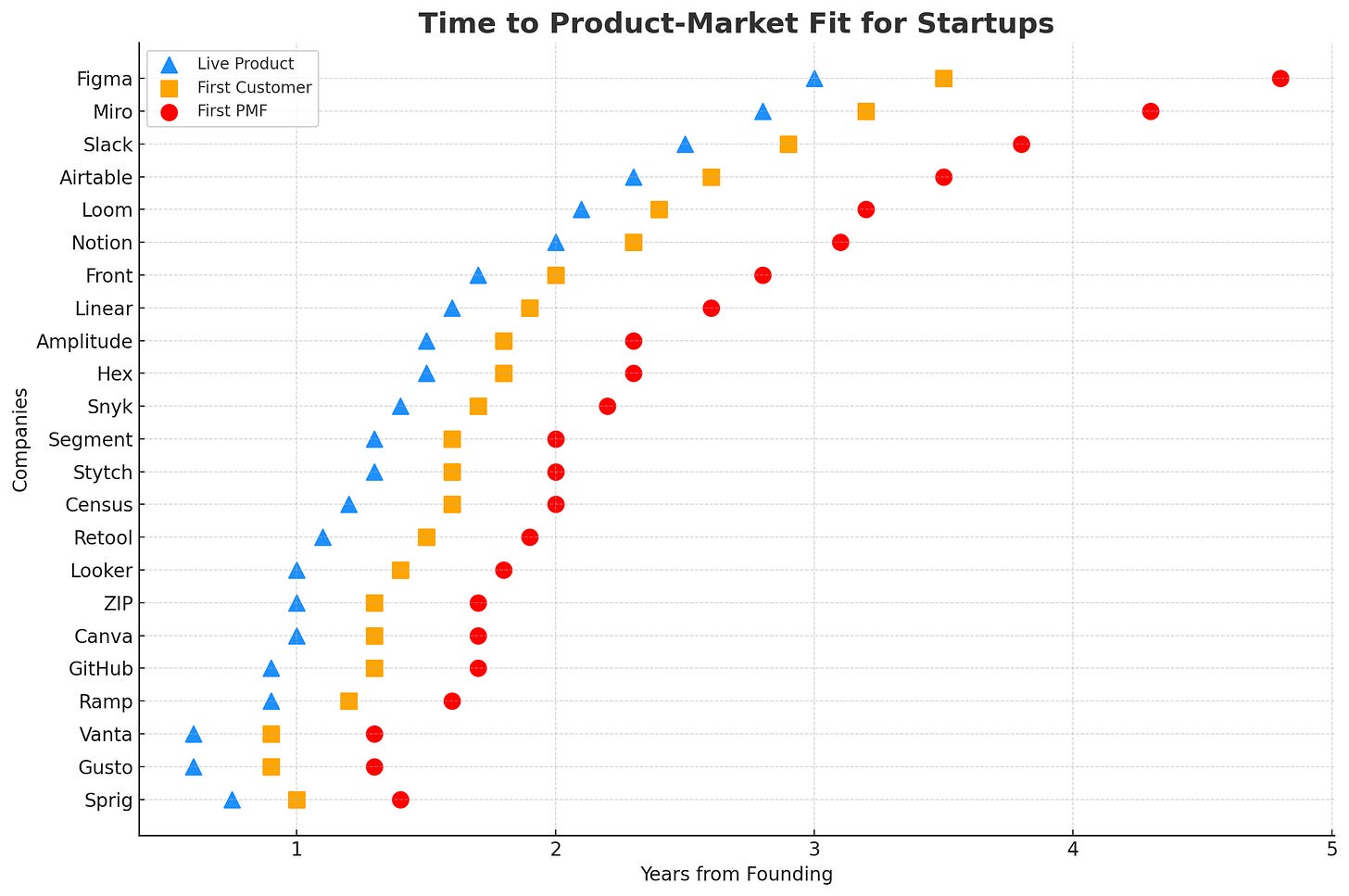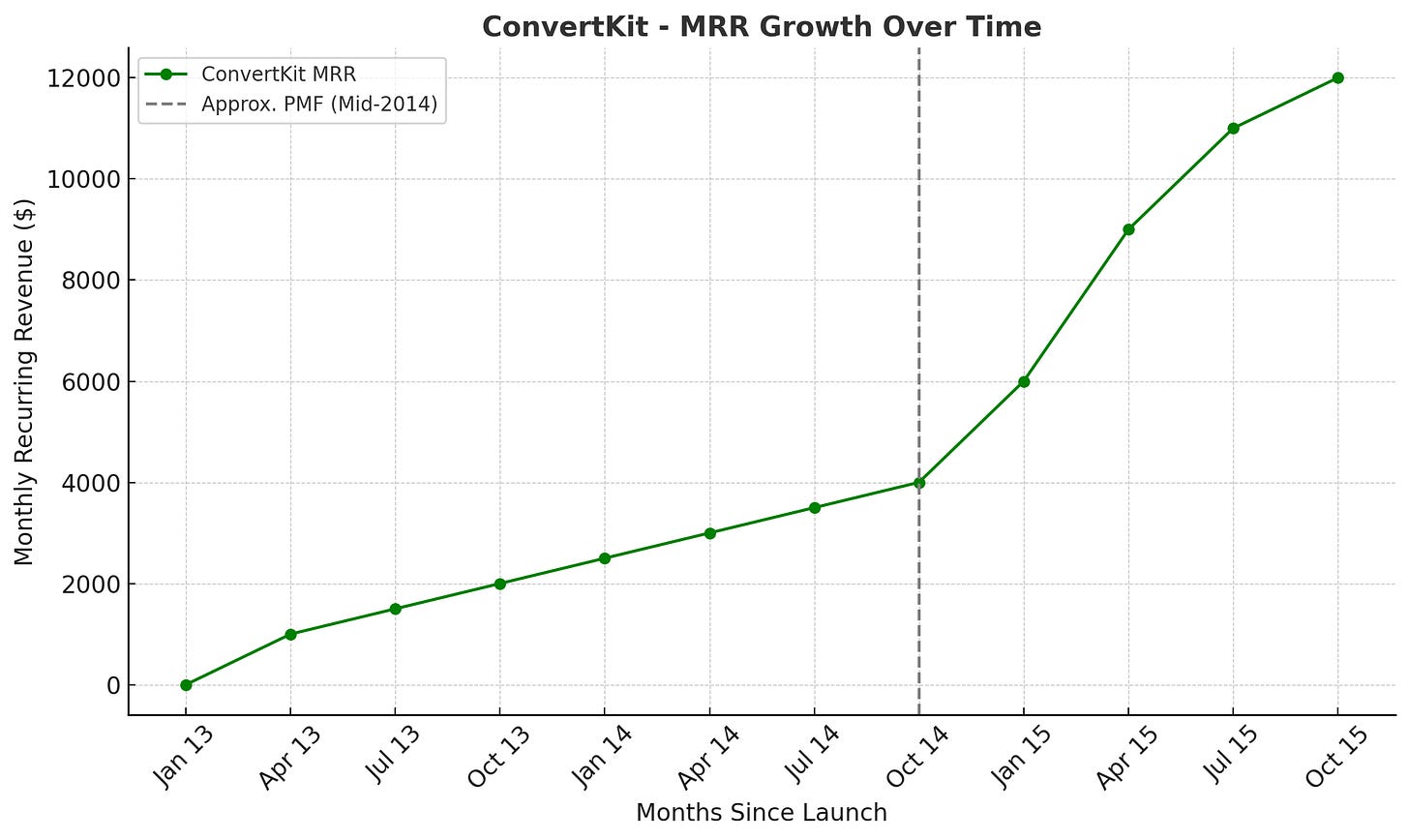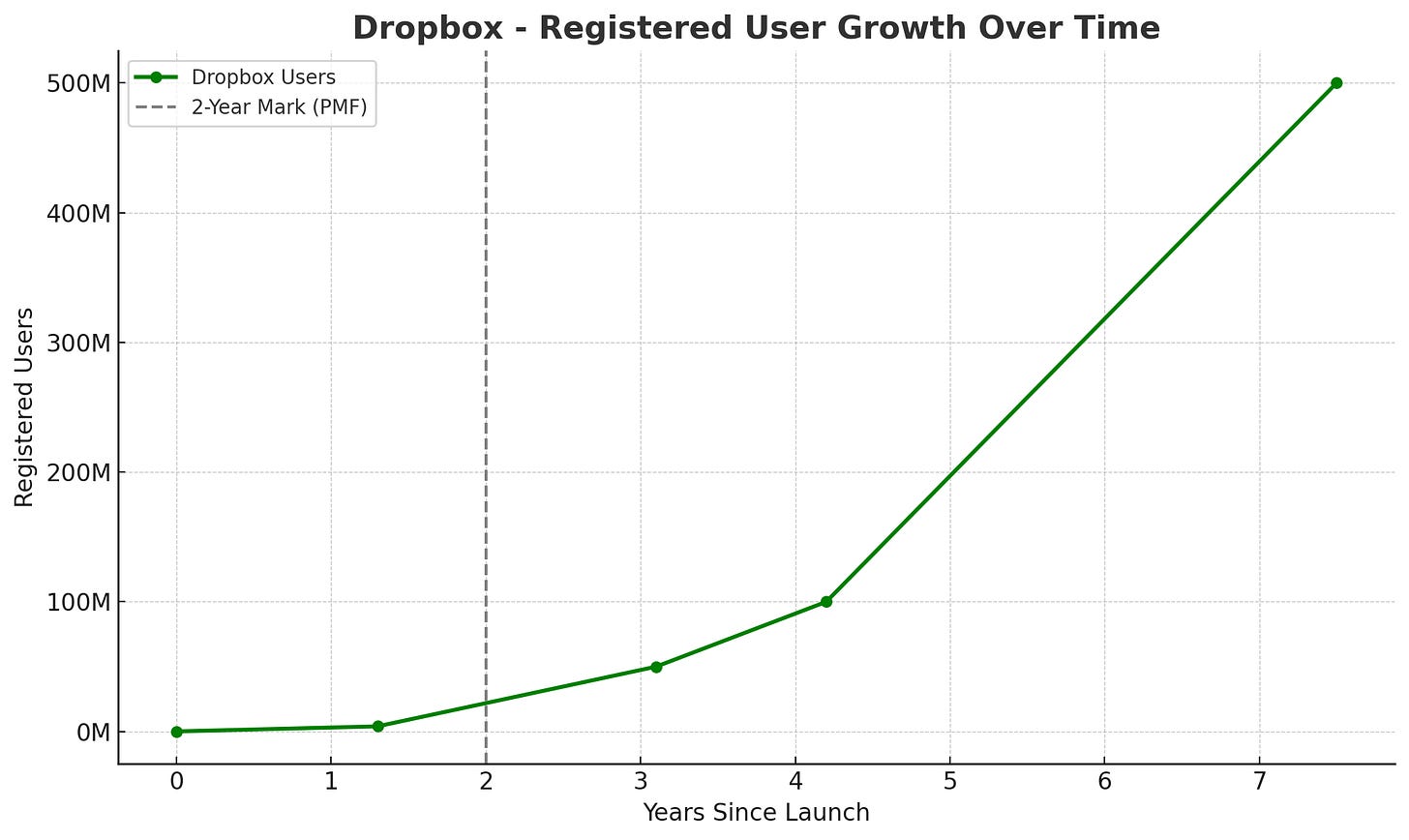Chewing glass and staring into the abyss—that’s the road to product-market fit (PMF).
The timeline is different for all of us. What makes this hard is there is no playbook, rules on how long you need to go for etc.
First things first—what is PMF supposed to feel like?
Some basic characteristics which I think we can all agree on:
Pull, not push: people are coming to you to solve their problems.
Repeatability: sales process remains consistent across customers.
Good retention rates: churn is at a healthy level for your segment.
Some volume: a solid enough sample size that represents a market.
In reality, even at $1M ARR, you probably won’t feel like you’ve hit PMF—because you’re a founder, and perpetual discontent comes with the territory.
Anyway, moving on.
This post will focus on knowing when to pivot and when to persist.
Benchmarking
Comparison is the thief of joy (when you don’t have the full picture).
Going to start with a visual I found a year ago, basically showing what the PMF timeline looked like for a range of successful B2B SaaS companies.
Around two years seems to represent the biggest cluster. That said, if this graph shows anything, it’s that there are no hard rules and there is a lot of variability.
Staring into the Abyss
Reaching for PMF is one thing—but when you're working off assumptions and have little data, it’s hard to know whether to push forward or try something new.
The first year is especially painful because you’re operating on proxies to tell you if something is maybe working or not.
Which means you need some pretty serious conviction.
Conviction’s a double-edged sword—the longer you push without traction, the line between belief and blind stubbornness blurs.
To give my two cents; founders go wrong when they obsess over the solution or product they've built, rather than the problem.
Obsess over the problem and work with users to create the solution.
This is the highest-probability path to PMF.
If you don’t have strong conviction about the problem to sustain two years of constant iterations—and possibly a pivot or two—pick a different problem.
If you find yourself perfecting a solution without a clear problem, take a step back.
Shit Takes Time
Patience and sunk cost are at odds. But the second biggest predictor of success—after IQ—is your ability to delay gratification.
Some things just take longer to build. If you're building a GPT wrapper and your gestation period is 2 months, chances are you don’t need 2 years.
If you're building complex design software to compete with an incumbent like Adobe (e.g. Figma), you will likely need a significantly longer gestation period.
Assuming you can detach emotionally from your product, the build process, and drop the ego, you’ll be more open to user feedback—and far more in tune with what actually matters.
We all have cognitive biases, but founders who are more self-aware, regulate ego and regularly self-reflect will fare better than those who bury their heads in the sand.
Be deliberate in your actions, listen carefully to prospects and give yourself the space—and time—to fail.
Everything takes longer than we think.
One of the last things someone told me at YC was:
Founders who stick it out for more than two years have a ~50% chance of exiting. Startups rarely die from running out of money—they die because founders burn out or fall out.
Since most of you are likely building a straightforward B2B SaaS product—not launching the next SpaceX—I’ll share a couple charts to help frame this.
Obviously, this is highly multi-factorial—but as I mentioned earlier, around two years tends to be where the biggest cluster lies.
ConvertKit
ConvertKit was bootstrapped, yet the growth curve truly took off at Year 2, marked by a sharp MRR spike. Funding aside, this is when the business hit its stride.
Dropbox
Dropbox was VC-backed, and its first major inflection point came around 18 months in. The exponential growth, however, didn’t kick in until around Year 4.
To reaffirm, there should still be signal on road to PMF.
If you’ve been stuck at $1K MRR for six months, building a vanilla SaaS product, struggling to book demos, and every day feels like an uphill slog with little sign of progress—then the next section might be more relevant to you.
Key Takeaways
Ignore the $0-$1M ARR headlines in 6 months.
Be prepared to sit in discomfort for a while.
Be patient; but not without reason.
If you make it past year 2, odds significantly improve.
Sunk Cost
Ego’s the enemy. Truth usually stings.
We’ve all met the founder who’s overly attached to their product—shocked it hasn’t gained traction, frustrated fundraising is hard and unwilling to pivot. The sunk cost is so high, the cognitive dissonance required to justify sticking with it is wild.
It’s easier to bury it than face the pain that’s coming.
To share a personal experience:
Before pivoting Vizzly, we built something no one asked for.
My default behavior is sales, so I went into pitch mode post-launch.
Rather than focusing on product discovery, I tried to drive sales and revenue by brute force before YC’s Demo Day. Instead of acknowledging the sunk cost, we kept digging for another 4 weeks—wasting even more time.
Eventually, we made the change—and prospects went from asking ‘why do I need this’ to ‘when can you build this’.
Great signal.
Deep down, if you know the message isn’t landing, try something new. It doesn’t have to be major—our pivot was relatively soft—but try something new.
The worst thing you can do is remain stagnant.
Movement generates information and data; it's how we learn.
Perceived sunk cost is always worse than the actual sunk cost.
You’re far better off wasting a few months than a year or two of your life—only to write it off as a “learning experience” after.
There’s no formula for knowing when to pivot—but you should be seeing signs like:
Genuine excitement about what you’re building.
Frustration that you can’t ship fast enough.
Willingness to pay for the solution now.
Key Takeaways
Ego ≠ Strategy. You are not your product.
Test, iterate, move—you won’t learn otherwise.
Customer pull is your earliest sign of PMF.
TL;DR
Things take longer than we think—that’s okay if you’re problem oriented.
Pay close attention to signals, feedback, and prospect interactions. Reaching $1M ARR shouldn’t feel out of reach—it should feel tangible. If things don’t feel right, keep moving—generate more data and keep learning. Just make sure you’re balancing that with giving yourself the time and space to fail.
Focus on the problem you’re solving; not the solution.
Everyone’s journey is different—but there’s a two-year cluster.
Ability to delay gratification (with a strong rationale) is an advantage.
Drop the ego and focus on real signs of customer pull.
You probably won’t ever feel like you’ve truly hit PMF.







Really good stuff Matt
Perhaps the key thing that founders need to remind themselves of more frequently:
Ego ≠ Strategy. You are not your product.
Thank you for sharing! Great writeup.